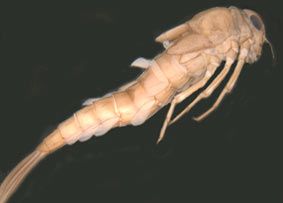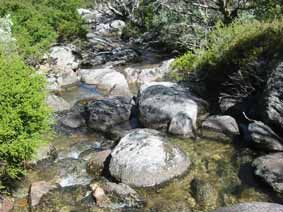Major Group: Insecta
Order: Ephemeroptera
Family: Nesameletidae (formerly Siphlonuridae)
Genus: Ameletoides
This family is represented in Australia by a single genus.
|
Descriptive Features: head hypognathous
antennae relatively short, about half width of head
clypeus and frons separated by distinct suture
single gills present on each maxilla
legs set close together, held ventral to the thorax
abdomen long, tapering to posterior, somewhat rounded in cross section
gills present on abdominal segments 1 to 7
each gill consisting of a single oval lamella, outer margin strengthened by heavily sclerotized band with series of small teeth along apical third, with additional sclerotized strut traversing the middle of the lamella, branched tracheae present but usually somewhat inconspicuous
caudal filaments with dense setal fringe along inner margins
Total length: up to 15 mm
|

|
Ameletoides lacusalbinae |
|
|

|
Ameletoides lacusalbinae, female |
|
Taxonomic Checklist:
Ameletoides lacusalbinae Tillyard
(3 morphospecies of nymphs)
|
|
Distribution: NSW, Vic, Tas
Sensitivity Rating: SIGNAL grade 10
Functional Feeding Group: scrapers
|

|
Snowy River, Kosciusko National Park NSW |
|
|
Ecology: Instream habitat: Ameletoides lacusalbinae is widespread, but rarely abundant, in cool, high altitude streams and some lakes.
Feeding ecology:Nymphs graze the tops of rocks and logs in the pools of streams in broad daylight, which makes them very susceptible to predation. The abundance of Ameletoides lacusalbinae nymphs is greatly affected by predatory fish such as native Galaxias and introduced trout. Presence of these fish can cause almost total disappearance of the nymphs.
Habit:
Life history: Females produce about 11 000 eggs. Nymphal development lasts up to two years with the adults emerging from September to January.
|
| |
Information Sources: Dean & Suter 1996, Webb & Suter 2012b, Peters & Campbell 1991, Campbell 1999, Gooderham & Tsyrlin 2002
Key to Species: Webb & Suter 2012b (morphospecies)
|
|
|
|